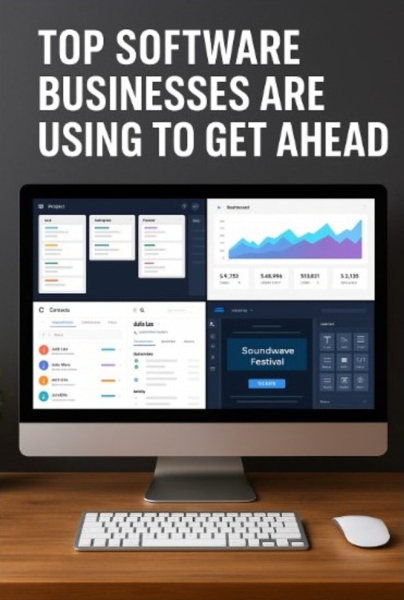Contents
- 1 Financial Contract Management Software: A Quiet Powerhouse
- 2 Most Popular Business Software Categories in 2025
- 3 The Evolution of Marketing Software
- 4 Productivity Software and the Rise of the Digital HQ
- 5 Air Quality Software for Compliance and Cleaner Indoor Air
- 6 Air Quality Software for Compliance and Cleaner Indoor Air
- 7 AI and Automation: Beyond Buzzwords
- 8 How to Choose the Right Software Stack
- 9 Software as a Competitive Edge
businesses aren’t just powered by people and ideas—they’re powered by software ecosystems. From finance and marketing to project management and automation, smart companies are leveraging powerful tools not just to streamline operations, but to outpace the competition. The truth is, it’s no longer just about working hard—it’s about working smarter, and the right software is a major part of that shift. Whether you’re a scrappy startup or a global player, choosing the right digital tools can be the difference between leading the market or lagging behind. Let’s take a deep dive into the types of software businesses are using in 2025 to scale faster, operate leaner, and grow stronger.
Financial Contract Management Software: A Quiet Powerhouse
One of the most quietly transformative categories of business software is financial contract management. Long considered a back-office burden, contract oversight has become mission-critical for industries like finance, real estate, legal services, SaaS, and even manufacturing. So what exactly does financial contract management software do? At its core, this software helps businesses create, store, track, and manage contracts related to financial obligations—including leases, loans, client service agreements, and vendor payment schedules. It brings structure and automation to what was once a manual, error-prone process.
Here’s why it matters: improved compliance—with regulations like IFRS 16 or ASC 842, companies need to recognize financial contracts on their balance sheets and track lease liabilities. Specialized software ensures that’s done correctly. It also centralizes access—contracts often live across departments and inboxes. A good platform centralizes them with access controls and version history. Automated reminders ensure you never miss a payment date or renewal window again. And for financial forecasting, accurate contract data feeds into your financial model, improving everything from budgeting to investor reporting. For growing businesses, this category of software is a hidden gem. It reduces legal risk, improves financial clarity, and eliminates time wasted on spreadsheets and manual follow-ups.
Most Popular Business Software Categories in 2025
Here’s a snapshot of the top categories of software businesses are integrating into their workflows right now:
- Project Management Tools – Platforms like Asana, Trello, and Monday.com are essential for keeping teams aligned, especially in remote or hybrid setups.
- Customer Relationship Management (CRM) – Salesforce, HubSpot, and Zoho CRM help companies manage leads, automate follow-ups, and boost retention.
- Marketing Automation Software – Tools like ActiveCampaign, Klaviyo, and Mailchimp allow targeted customer journeys with minimal manual effort.
- Accounting and Bookkeeping Platforms – QuickBooks, Xero, and NetSuite bring financial visibility and automation to your back office.
- Communication Suites – Slack, Microsoft Teams, and Zoom dominate internal communication and client engagement.
- Cloud Storage & Collaboration – Google Workspace and Dropbox make document sharing seamless across teams and time zones.
- HR and Payroll Software – Gusto, BambooHR, and Rippling help streamline hiring, benefits, and compliance.
- AI Content Tools – Jasper, Copy.ai, and ChatGPT are now integral for content marketing, brainstorming, and more.
Each of these tools addresses a unique pain point, and when integrated wisely, they create an ecosystem where your business runs like a finely tuned machine.
The Evolution of Marketing Software
Marketing software has undergone a dramatic evolution—from simple email tools to integrated AI-powered ecosystems that handle everything from campaign ideation to conversion tracking. Modern marketing teams rely on these platforms not just for sending messages, but for making data-driven decisions and maximizing ROI. Consider a mid-sized business launching a product in multiple regions. With the right marketing stack, they can: build audience segments based on behavior, interests, or purchase history; launch dynamic email campaigns tailored to each user; run automated social media scheduling and ads; track engagement and click-throughs in real-time; and adjust campaigns based on A/B testing and funnel analytics.
Software like HubSpot, Marketo, and Sendinblue act as marketing control centers, while more niche tools like Canva Pro, Buffer, and Figma assist with design, content, and collaboration. Many platforms now include AI writing assistants, predictive analytics, and built-in CRM functionalities. And let’s not forget the role of retargeting and attribution tools. With platforms like Segment or Google Analytics 4, marketers can finally see which channels are truly driving conversions—and adjust spend accordingly. Marketing today isn’t about gut feeling; it’s about data science. And software is what makes that possible.
Productivity Software and the Rise of the Digital HQ
The office of 2025 isn’t in a building—it’s in the cloud. With remote and hybrid work now the norm, productivity software has become the backbone of daily operations. Companies are embracing what’s being called a “digital HQ”—a place where all communication, documentation, and collaboration happens, regardless of physical location.
Slack has become a virtual watercooler. Google Docs replaces in-office whiteboarding. Loom or Zoom replaces in-person meetings. And tools like Notion or ClickUp give teams a place to plan, write, and build—all in one workspace. Integrations are key. A smart digital HQ connects your calendar, CRM, file system, and chat, so nothing slips through the cracks. Time-saving features like automated workflows, AI meeting summaries, and collaborative editing turn hours of manual effort into minutes. Ultimately, productivity tools let businesses scale without sacrificing agility. Small teams can act big, and big teams can move fast.
Air Quality Software for Compliance and Cleaner Indoor Air
As government regulations around indoor environmental health grow more stringent—especially in sectors like education, healthcare, and manufacturing—air quality software has become a vital compliance tool. These platforms track and log pollutant levels such as CO₂, VOCs, and fine particulate matter (PM2.5), making it easier for businesses to meet air safety standards and submit required reports. But beyond compliance, this software empowers companies to improve real-world air conditions by identifying problem areas in real time.

Air Quality Software for Compliance and Cleaner Indoor Air
As government regulations around indoor environmental health grow more stringent—especially in sectors like education, healthcare, and manufacturing—air quality software has become a vital compliance tool. These platforms track and log pollutant levels such as CO₂, VOCs, and fine particulate matter (PM2.5), making it easier for businesses to meet air safety standards and submit required reports. But beyond compliance, this software empowers companies to improve real-world air conditions by identifying problem areas in real time. When paired with commercial-grade air purifiers, the combination becomes especially effective: the software pinpoints zones of concern, while purifiers actively clean the air—creating a dynamic system that’s both responsive and measurable. Businesses can then prove, with data, that their indoor spaces aren’t just up to code—they’re genuinely healthier for employees and visitors alike.
AI and Automation: Beyond Buzzwords
AI in business is no longer experimental—it’s foundational. Software powered by AI is transforming every function from customer service to finance. Take AI-driven analytics tools like Tableau with Einstein AI or Power BI. They don’t just report data; they analyze trends, flag anomalies, and offer predictive insights.
Then there’s AI in customer service. Platforms like Intercom, Drift, or Zendesk now come equipped with chatbots that learn over time, improving customer experience without increasing headcount. Process automation tools like Zapier, Make.com, and Workato are also booming. These apps connect your different software platforms and trigger actions across them. For example, when a lead signs up via your website, they can be automatically added to your CRM, sent a welcome email, and assigned a rep—all without lifting a finger. Businesses using AI-powered automation aren’t just saving time—they’re moving faster, closing gaps, and reducing human error.
How to Choose the Right Software Stack
With all this innovation, how do you choose which tools are right for your business? Start with your pain points. Are you losing leads? Struggling to stay organized? Bogged down with manual invoices? Your biggest bottlenecks should guide your software decisions.
Then, consider: scalability—will the software grow with you? Ease of integration—can it plug into the tools you already use? Support and onboarding—does it come with training or customer service? Data security—is it compliant with your industry’s privacy standards? Team adoption—will your people actually use it?
Trial periods and demos are your friends. Take time to test before you invest.
Software as a Competitive Edge
The right software won’t solve every business problem, but it will amplify your strengths and eliminate inefficiencies. In today’s fast-paced economy, agility matters—and software gives you that edge. Whether it’s managing financial contracts, scaling marketing, improving productivity, or automating the mundane, modern tools empower even the leanest teams to do extraordinary things. So if you’re still on the fence about upgrading your tech stack, remember this: businesses that invest in software don’t just keep up—they lead.



